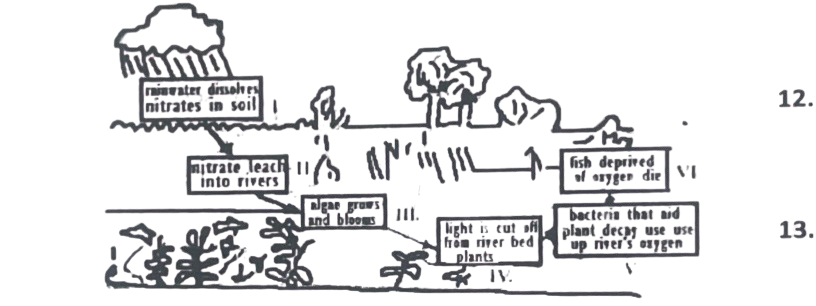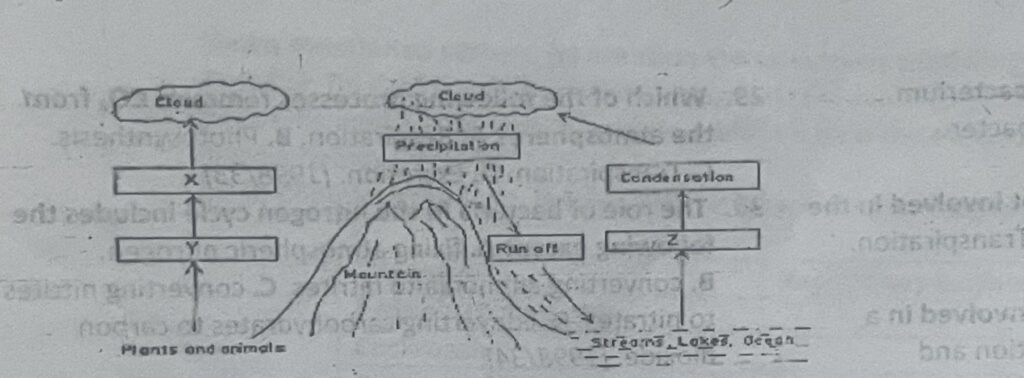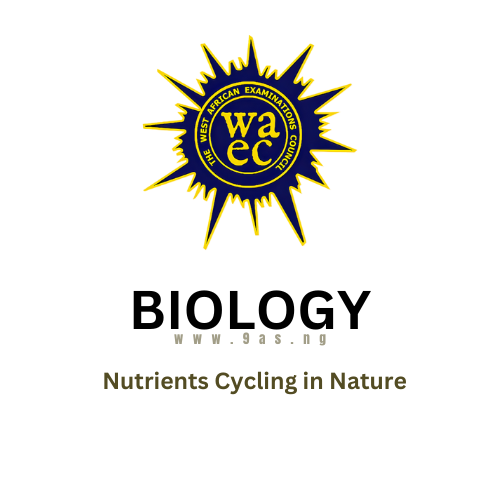Introduction:
Nutrient cycling is a fundamental ecological process that ensures the continuous supply and movement of essential elements like carbon, nitrogen, phosphorus, and water within ecosystems. These cycles maintain the balance of nutrients, supporting life by enabling growth, reproduction, and energy transfer among organisms.
Key Concepts:
1. Definition of Nutrient Cycling:
Nutrient cycling refers to the movement and exchange of organic and inorganic matter back into the production of living matter. This process involves the recycling of nutrients through biological, geological, and chemical pathways, ensuring the sustainability of ecosystems.
2. Importance of Nutrient Cycling:
- Maintains ecosystem stability by replenishing essential nutrients.
- Supports plant growth and productivity.
- Facilitates energy flow through food chains.Wikipedia
- Regulates atmospheric gases, influencing climate patterns.
3. Major Nutrient Cycles:
- Carbon Cycle:
- Involves the exchange of carbon among the atmosphere, biosphere, oceans, and geosphere.
- Key processes include photosynthesis, respiration, decomposition, and combustion.
- Nitrogen Cycle:
- Describes the transformation and movement of nitrogen through the atmosphere, soil, and living organisms.
- Key processes:
- Nitrogen Fixation: Conversion of atmospheric nitrogen (N₂) into ammonia (NH₃) by nitrogen-fixing bacteria.
- Nitrification: Oxidation of ammonia to nitrites (NO₂⁻) and then to nitrates (NO₃⁻) by nitrifying bacteria.
- Assimilation: Uptake of nitrates by plants to synthesize proteins and nucleic acids.
- Ammonification: Decomposition of organic nitrogen back into ammonia by decomposers.
- Denitrification: Reduction of nitrates back to nitrogen gas (N₂) by denitrifying bacteria, returning it to the atmosphere.
- Phosphorus Cycle:
- Involves the movement of phosphorus through the lithosphere, hydrosphere, and biosphere.Wikipedia
- Unlike other cycles, it does not include a gaseous phase.
- Key processes include weathering of rocks, absorption by plants, and return to the soil through decomposition.
- Water Cycle (Hydrological Cycle):
- Describes the continuous movement of water on, above, and below the Earth’s surface.
- Key processes:
- Evaporation: Transformation of water from liquid to vapor.
- Condensation: Conversion of water vapor into liquid droplets, forming clouds.
- Precipitation: Release of water from clouds as rain, snow, sleet, or hail.
- Transpiration: Evaporation of water from plant leaves.
- Infiltration and Runoff: Movement of water into the soil and across the land surface into water bodies.
4. Roles of Microorganisms in Nutrient Cycling:
- Nitrogen-Fixing Bacteria: Convert atmospheric nitrogen into forms usable by plants (e.g., Rhizobium in legume root nodules).
- Nitrifying Bacteria: Oxidize ammonia into nitrites and then nitrates (e.g., Nitrosomonas and Nitrobacter).
- Denitrifying Bacteria: Reduce nitrates back to nitrogen gas, completing the nitrogen cycle (e.g., Pseudomonas species).
- Decomposers: Break down dead organisms, returning nutrients to the soil.
5. Human Impact on Nutrient Cycles:
- Agricultural Practices: Use of fertilizers can lead to nutrient runoff, causing eutrophication in water bodies.
- Deforestation: Reduces the capacity of ecosystems to store and recycle nutrients.
- Combustion of Fossil Fuels: Increases atmospheric CO₂, affecting the carbon cycle and contributing to climate change.
- Waste Disposal: Improper disposal can disrupt natural nutrient balances.Wikipedia
6. Diagrammatic Representation:
[Insert labeled diagrams of the Carbon, Nitrogen, Phosphorus, and Water cycles to visually illustrate the processes involved.]
Study Tips:
- Understand Terminology: Familiarize yourself with key terms such as nitrification, denitrification, and eutrophication.
- Use Diagrams: Practice drawing and labeling the various nutrient cycles to reinforce understanding.
- Compare Cycles: Create comparison tables to highlight differences and similarities between the nutrient cycles.
- Review Past Questions: Use the questions below for study and practice.
- Engage in Group Discussions: Discussing topics with peers can enhance comprehension and retention.
Conclusion:
A thorough understanding of nutrient cycling is essential for success in the WAEC Biology examination. By mastering the processes and significance of each cycle, students can appreciate the intricate systems that sustain life and the impact of human activities on these natural processes.
OBJECTIVES
1. The part of a leguminous plant where bacteria like Azotobacter can be found is
A. at the nodes of the stem. B. at the internodes. C. in the root nodules. D. in the spongy mesophyll.
2. What is the benefit of thunder and lightning to farmers?
A. Addition of nitrates to the soil. B. Aeration of the soil. C. Removal of harmful bacteria from the soil. D. Addition of rain water to the soil.
3. The bacteria that reduce nitrates.in the soil in the gaseous nitrogen are referred to as
A. nitrifying bacteria. B. denitrifying bacteria. C. putrefying bacteria. D. saprophytic bacteria.
The diagram below shows the, effect of nitrates water bodies. Study it carefully and answer this question 4
4. The source of the nitrates in the part, labelled I is the

A. root nodules of legumes. B. cloud. C. fertilizers. D. organic matter.
5. The bacterium in a mutualistic association with legumes converts
A. nitrates to ammonia. B. ammonium compounds to nitrites. C. nitrogen gas to ammonia. D. nitrites to nitrates.
6. Which of following statements about the circulation of water in nature is not correct? Water
A. constantly evaporates from seas, rivers, lakes and soil. B. vapour rises, cools, condenses and precipitates as rain and dew. C. removed from oceans is permanently lost. D. is lost in plants by transpiration and decay.
7. Which of the following cycles involves the process of precipitation and transpiration?
A. Water cycle. B. Carbon cycle. C. Nitrogen cycle. D. Oxygen cycle.
8. Which of the following methods does not make water fit for drinking?
A. Addition of chlorine. B. Boiling. C. Distillation. D. Addition of alum.
9. Which of the following processes removes carbon from the atmosphere?
A. Putrefaction. B. Photosynthesis. C. Volcanic eruption. D. Burning of fuels.
10. The effect of chlorofluorocarbon is
A. reduction of oxygen concentration in the atmosphere. B. depletion of the ozone layer. C. screening of ultra-violent rays. D. Increase in carbon dioxide concentration.
11. Which of the following substances is not recycled in an ecosystem?
A. Carbon, B. Energy. C. Water. D. Nitrogen.
12. Which of the following processes removes carbon (IV) oxide from the atmosphere?
A. Burning fuels. B. Putrefaction. C. Photosynthesis. D. Respiration in plants.
13. Which of the following organisms reduces nitrates in the soil to gaseous nitrogen?
A. Euglena. B. Protozoan. C. Denitrifying bacterium. D. Parasitic mould.
14. Which of the following is responsible for the conversion of nitrites to nitrates in the nitrogen cycle?
A. Denitrifying bacteria. B. Nitrifying bacteria. C. Lightening. D. Fungi.
15. The process whereby microorganisms can convert atmospheric nitrogen into nitrogenous compound is known as
A. nitrogen cycle. B. nitrogen fixation. C. dentrification. D. putrefaction.
16. Thunderstorm can be beneficial to plants because it
A. kills the pest that attacks crops. B. destroys some of the major crops. C. adds nitrates to the soil. D. adds lime to the soil.
17. Which of the following is a nutrifying bacterium
A. Nitrobacter. B. Rhizobium. C. Azotobacter. D. Clostribium.
18. Which of the following processes is not involved in the carbon cycle?
A. Burning. B. Decay. C. Transpiration. D. Respiration.
19. Which of the following processes are involved in a water cycle?
A. Evaporation, condensation and precipitation. B. Evaporation, percolation and transpiration. C. Evaporation and precipitation. D. Evaporation and transpiration.
20. In which of the following processes is carbon dioxide roots. B. they possess root nodules containing not given out?
A. Respiration in plants. B. Decay of organism. C. Burning of organic matter. D. During photosynthesis.
21. Sea water taken in by a living organism can be recycled into the atmosphere through all the following processes except
A. transpiration. B. digestion. C. excretion. D. respiration.
22. Which of the following statements about nitrogen is not correct? Nitrogen is needed for
A. protein sin synthesis. B. activating certain enzymes. C. the synthesis of chlorophyll. D. healthy vegetative growth of plants.
23. Which of the following processes removes water from the water cycle?
A. Condensation. B. Perspiration. Rhizobium. C. they have a well developed root system. D. they are autotrophic.
24. The role of dead organic matter in the soil is to
A. make the soil black. B. increase the mineral salt content. C. provide food for all living organisms. D. increase the acidity of soil.
25. Which of the following is not released during decay of living matter?
A. Ammonia. B. Oxygen. C. Carbon dioxide. D. Heat energy.
26. Which of the following processes does not contribute to the maintenance of the nitrogen content of the soil
A. Decompostion. B. Dentrification. C. Nitrification. D. Nitrogen fixation.
27. The reduction of nitrates to gaseous nitrogen is
A. nitrogen fixing. B. nitrogen cycle. C. ammonification. D. dentrification.
28. Which of the following bacteria reduces nitrates in the soil to gaseous nitrogen?
A. Putrefying bacteria. B. Nutrifying bacteria. C. Saprophytic bacteria. D. Denitrifying bacteria.
29. Which of the following processes removes CO₂ from “the atmosphere?
A. Respiration. B. Photosynthesis. C. Transpiration. D. Excretion.
30. The role of bacteria in the nitrogen cycle includes the following except
A. fixing atmospheric nitrogen. B. converting ammonia to nitrites. C. converting nitrites to nitrates. D. converting carbohydrates to carbon dioxide.
31. Legumes incorporate nitrogen gas into their proteins because
A. of the presence of Azotobacter in their roots. B. they posses root nodules containing Rhizobium. C. they have a well developed root system. D. they are autotrophic.
32. Which of these is not applicable to the circulation of water in nature?
A. Water removed from oceans are permanently lost. B. Water constantly evaporates from the seas, rivers, lakes and soil. C. Water vapour rises, cools, condenses and precipitates as rain and dew. D. Water is absorbed by plants and animals from their external environment.
33. Which of the following fixes atmospheric nitrogen?
A. Rhizobium. B. Nitrosomonas. C. Nitrobacter. D. Putrefying bacteria.
34. Which of the following processes will not introduce carbon dioxide into the atmosphere?
A. Breathing. B. Photosynthesis. C. Respiration. D. Putrefaction.
35. Carbon is added to the atmosphere by the following processes except
A. respiration. B. burning. C. Photosynthesis. D. volcanic eruption
36. Which of the following is an effect of carbon monoxide on man?
A. irritating the skin. B. Reducing oxygen carrying capacity of blood. C. Causing gene mutation. D. Destroying white blood cells.
37. The pathway through which nutrient elements are replenished and circulated in an ecosystem is called a
A. cycle. B. food chain. C. food web. D. Kreb’s cycle.
38. All the following can illustrate the dynamic nature of the ecosystem except
A. nitrogen cycle. B. carbon cycle. C. water cycle. D. locomotion in organisms.
39. The conversion of ammonium salts into nitrates is called
A. putrefaction. B. denitrification. C. fixation. D. nitrification.
THEORY
1. (a) Describe three ways by which nitrogen is added to the soil for plant use. (b) State two ways by which nitrogen is lost from the soil.
2. (a) Explain the following terms; (i) putrefaction; (ii) nitrogen fixation (iii) nitrification (iv) denitrification. (b) State three differences between nitrogen fixation and denitrification. (c) Explain how nitrogen from urine gets to the roots of plants.
3. (a) Describe the carbon cycle (b)State the functions of: (i) nitrogen fixing bacteria (ii) nitrifying bacteria; (iii) Denitrifying bacteria in nature;
4. Make a labelled diagram of the carbon cycle.
5. With the aid of annotated diagrams only, outline the water cycle.
6. With the aid of a diagram, describe the carbon cycle.
7. List five ways by which nitrogen can be made available to the soil for plant growth.
8. Describe what happens during the denitrification stage of the nitrogen cycle.
9. Explain briefly the importance of the following factor and organisms in the nitrogen cycle. (i) lightning (ii) Nitrosomonas (iii) Azotobacter.
10. Complete the table below by naming the nutrient cycle that involves each of the given processes and give three other processes involved in the nutrient cycle.
| Process | Nutrient Cycle | Three other processes involved in the named nutrient cycle |
11. The diagram below is an illustration of a biological cycle. Study it and answer questions 5(b)(i) to 5 (b)(ii)

(i) Name the biological cycle. (ii) Explain briefly three roles played by plants and animals in the cycle. (iii)Name the processes that occur in X, Y and Z.
12. (i) What is decay of organic matter? (ii) Name two groups of organisms that cause decay of organic matter. (iii) State one other factor that causes decay. (iv) Name the biological cycle that involves decay.
13. List four organisms involved in the nitrogen cycle and state one role each of the organism.


